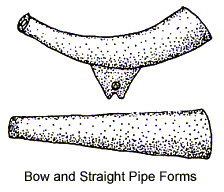Ceramic Pipes
Ceramic smoking pipes are an uncommon artifact type in San Diego County. Two main pipe styles have been recognized: a straight, tubular form; and a curved, bow-shaped form with a flanged handle. Within the first type, a subtype of pipes with a flared bowl has sometimes been distinguished.
 Several ethnographers and archaeologists have suggested that pipe forms might be correlated with ethnic traditions:
Several ethnographers and archaeologists have suggested that pipe forms might be correlated with ethnic traditions:
- Philip Stedman Sparkman (1908) reported that the Luiseño used short, tubular pipes.
- Leslie Spier (1923) noted that the southern Kumeyaay used bow pipes. He specifically denied that they used the straight form.
- According to Edward W. Gifford (1931), the Kumeyaay of Imperial Valley did not use ceramic pipes at all.
- Malcolm J. Rogers (1936) apparently combined ethnographic and archaeological information when he reported that bow pipes were most common among the northern Kumeyaay (Ipai) and probably originated among them, that southern Kumeyaay also used bow pipes exclusively, and that the pipes of the Luiseño, Cupeño, and Cahuilla were straight in form and relatively few in number. Discussing archaeological observations relating to the lower Colorado River area, Rogers (1945) attributed straight ceramic pipes to the Yuman I period (prior to ca. A.D. 1050) and did not assign any pipe form to Yuman II or to Yuman III.
- D. L. True (1966, 1970; True et al. 1991) observed archaeologically that the bow pipe was typical of Kumeyaay territory, but that occasional specimens were found in Luiseño territory. He classified ceramic pipes among the artifact types that he “believed to have potential future diagnostic value” for distinguishing Yuman from Uto-Aztecan assemblages (True 1966:237-239).
- Gena R. Van Camp (1979) reiterated Rogers’ views, although adding that bow pipes were infrequent in the northern portion of Kumeyaay territory as compared to the southern portion.
- Jackson Underwood (2004) reviewed ethnographic evidence concerning pipe forms and contexts of tobacco use among the Yuman and Uto-Aztecan groups of southern California. Among his conclusions was that bow pipes were not treated as ceremonial objects.
A summary of archaeologically reported pipes and pipe fragments in the table below shows a somewhat greater proportion of straight pipes in Luiseño territory than in either northern or southern Kumeyaay territory, although the contrast is not statistically significant, according to a chi-square test.
| Site | Ethnic Territory (Heizer 1978) |
Straight | Bow | Other or Not Specified |
References |
| SDI-217 | Luiseño | — | — | 1 | Waugh 1986 |
| SDI-308 | Luiseño | 1 | 2 | 5 | True et al. 1974 |
| SDI-616 | Luiseño | 3 | 2 | — | True 1966 |
| SDI-682 | Luiseño | 3 | 6 | 9 | True et al. 1991 |
| SDI-721 | Luiseño | — | 3 | — | True 1966 |
| SDI-789 | Luiseño | — | 3 | — | True 1966 |
| SDI-5353 | Luiseño | — | 1 | — | Koerper et al. 1992 |
| SDI-799 | Cupeño | — | — | 1 | White et al. 1983 |
| SDI-4513 | Ipai | — | — | 1 | Gallegos et al. 1989 |
| SDI-5017 | Ipai | — | 1 | — | Winterrowd and Cardenas 1987 |
| SDI-5383 | Ipai | — | — | 1 | Norwood 1982 |
| SDI-5426 | Ipai | — | 1 | 1 | Van Horn 1988 |
| SDI-55224 | Ipai | — | 1 | — | Wade et al. 1990 |
| SDI-5669 | Ipai | — | 1 | 23 | Berryman 1981 |
| SDI-5680 | Ipai | — | — | 1 | Dominici 1985 |
| SDI-5938 | Ipai | — | 1 | 1 | Pigniolo 1987 |
| SDI-11,068 | Ipai | — | 3 | — | Schroth and Gallegos 1991 |
| SDM-W-1556 | Ipai | 1 | — | — | O’Neil 1982 |
| SDI-860 | Tipai | 2 | 13 | 46 | True 1966, 1970 |
| SDI-903 | Tipai | — | — | 1 | Gross and Sampson 1990 |
| SDI-913 | Tipai | — | present | – | True 1966 |
| SDI-2537 | Tipai | — | 2 | 4 | Griset 1986 |
| SDM-C-144 | Tipai | — | — | 2 | True 1966 |
| SDI-W-202 | Tipai | — | — | 1 | True 1966 |
| SDM-W-256 | Tipai | — | — | 10 | True 1966 |
| SDM-W-348 | Tipai | — | — | 1 | Cardenas and Van Wormer 1984 |
Besides contrasts in ethnic traditions, other explanations for the existence of distinct pipe forms might be that the pipes were non-local exchange items, that the manufacturing of one form predated the other, and that different forms were used primarily in different functional contexts (e.g., recreational smoking, shamanism or curing, and funeral observances).
PROSPECTS
Future archaeological investigations may be able to shed light on the distribution of different pipe forms within different ethnic territories, during different time periods, and within different functional contexts.